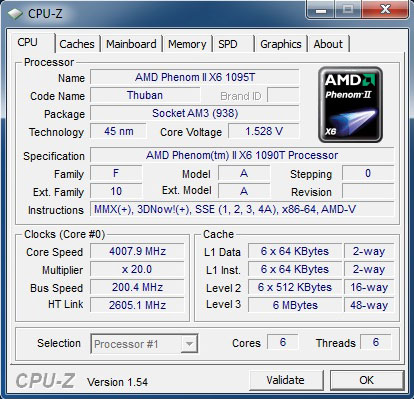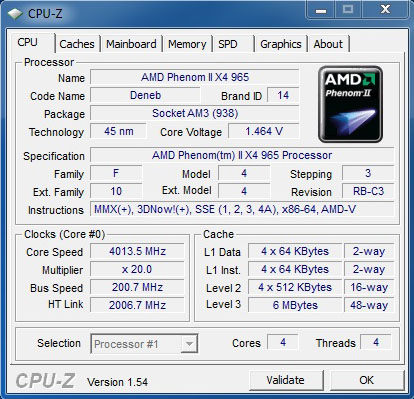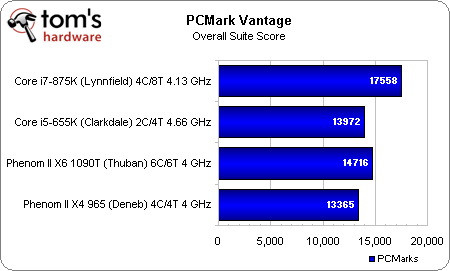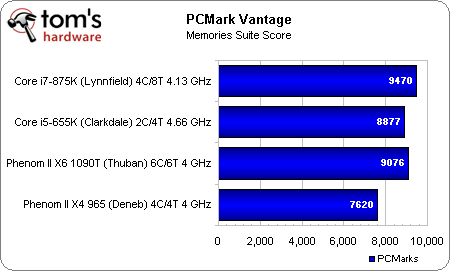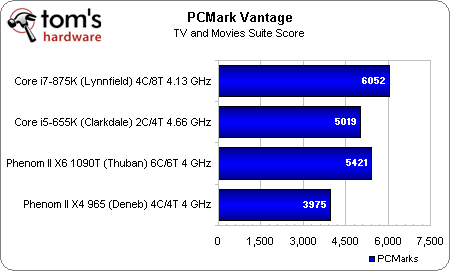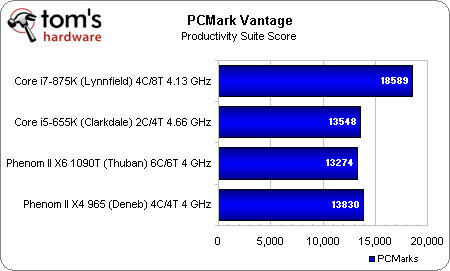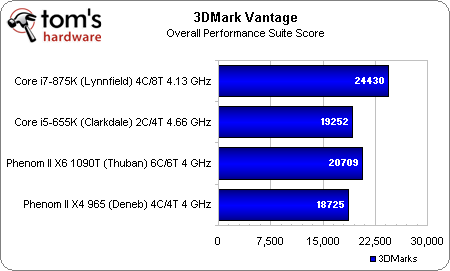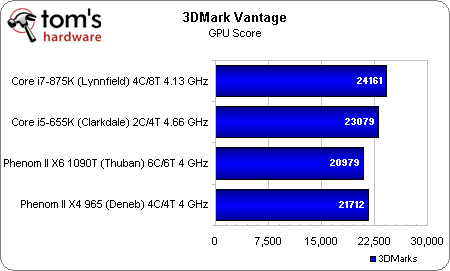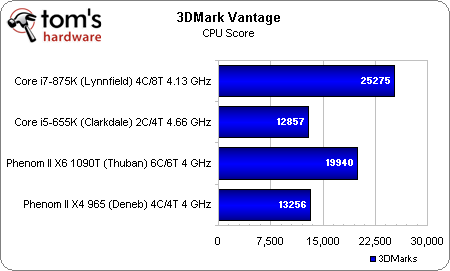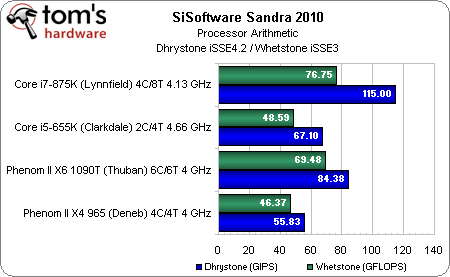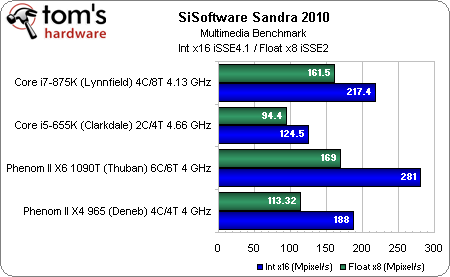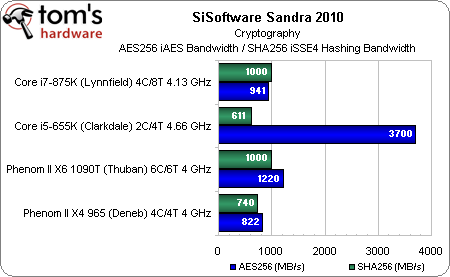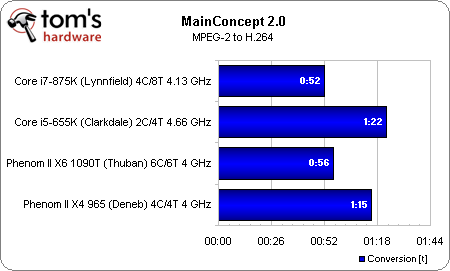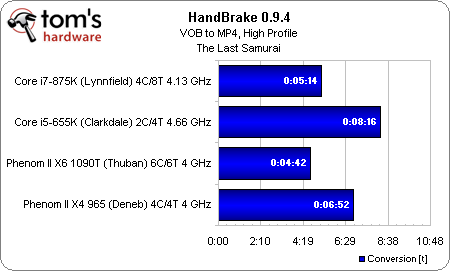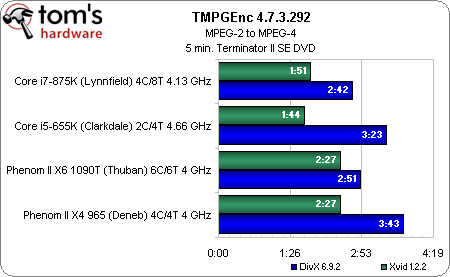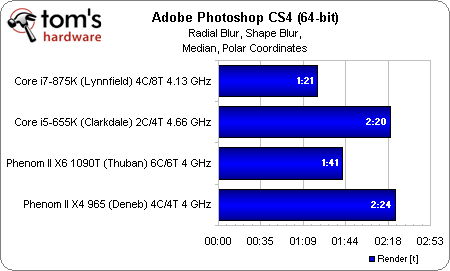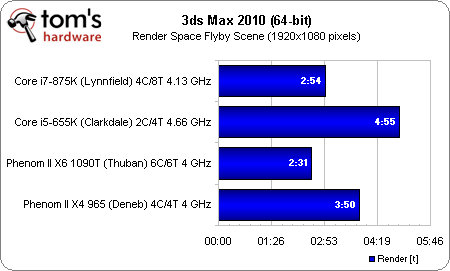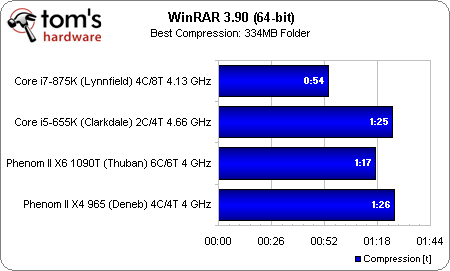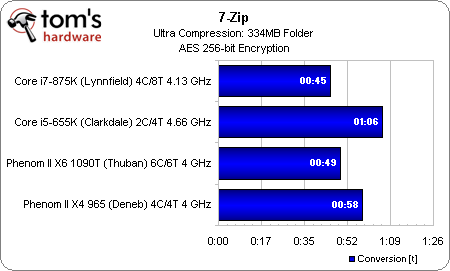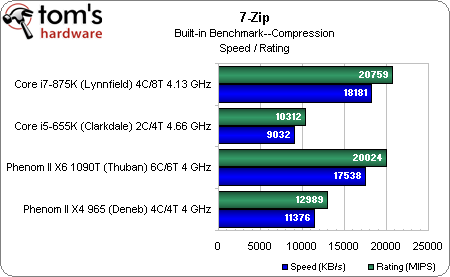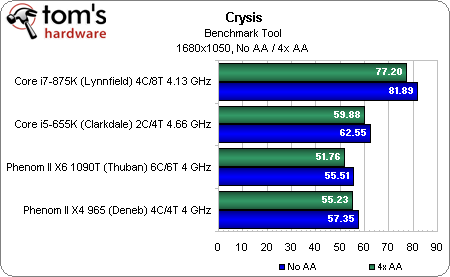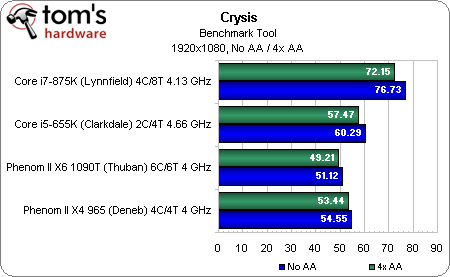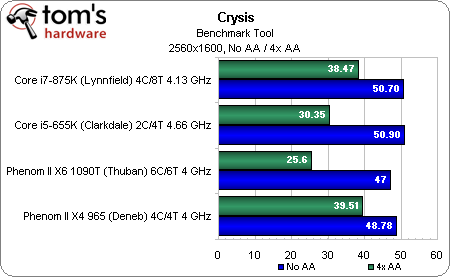
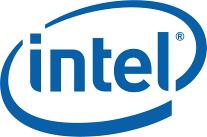

|
TopNax |
|
Home†††††† Previous††††††† AMD page†††††††† Intel page†††††††† Next |
AMD: Two CPUs At 4 GHz |
|
Phenom II X6 1090T Unlocked Phenom IIs are far less novelóAMD has been doing this for years.††† No doubt, the excitement over seeing Intel follow suit stems from the companyís advanced manufacturing technology, which facilitates the massive scalability we got out of the Core i5-655K. AMDís 45 nm process is no slouch, though. The company was able to introduce a six-core processor at the same 125W TDP as previous quad-core models. According to AMD, this is a result of adding low-k dielectric material in the metal layers to reduce capacitance. Low-leakage parts mean less heatóand thatís good for overclocking on air (the high-end guys actually prefer high-leakage parts, since they overclock more aggressively, and dissipating heat using LN2 isnít really a challenge).
I struggled to get the hexa-core 1090T stable at 4.3 GHz with Turbo CORE enabled. Then it was 4.2 or even 4.1 GHz. At each setting, general instability kept us from finishing testing (and heat wasnít even the issue, despite voltages of up to 1.525V). At the end of the day, the X6 1090T was dialed in at 4 GHz with a voltage of 1.475V. The screenshot below was snapped before we started scaling back voltage at 4 GHz to minimize power use. I won't be surprised if this chip doesn't make it to my next processor review, though. It was definitely ridden hard and put away wet. Phenom II X4 965 Available under $200, the quad-core Phenom II X4 965 makes a good contender for the Core i5-655K (though itís worth noting you can get a six-core Phenom II X6 1055T for less, as well; we simply havenít purchased any yet).
Our 125W sample proved just as stubborn above 4 GHz as the Phenom II X6 1090T, despite our oversized cooler, 1.5V+ CPU VID, and 1.25V NB VID. Prime95 simply wouldnít let this chip dig in at 4.2 or 4.1 GHz. Nevertheless, we were happy to settle down to a 1.4625V setting while retaining stability at 4 GHz. And with that, all four of our test subjects were running at 4 GHz or higher and ready for a dash through the gauntlet. |
Test Setup And Benchmarks |
Benchmark Results: Synthetics |
|
For the most part, Vantage paints a picture we pretty much expected to see. Mainly, the quad-core, Hyper-Threading-equipped Core i7-875K throws down the highest numbers, followed by AMDís hexa-core Phenom II X6 1090T. The battle between the Core i5 and Phenom II X4 is surprisingly close, considering the significant clock rate disparity.
Reflecting a proclivity for threading, the 3DMark CPU scores are perhaps most interesting. There we see the Lynnfield-based processor score first, followed by the Thuban-based X6. AMDís Deneb-based X4 snags third, followed closely by the Clarkdale-based Core i5.
|
Benchmark Results: Media And Transcoding |
|
iTunes continues serving one interesting purpose: demonstrating the merits of high clock rates. The 4.66 GHz Core i5 actually finishes our workload first. Because iTunes isnít threaded, it gains nothing from the chips with four or six cores. As such, itís a little surprising to see the Phenom II X4 and X6 with nine seconds separating them. More often than not, though, both 4 GHz parts should be on equal footing in single-threaded titles at the same frequency.
Weíve upgraded to the newest version of MainConcept, which shows the Core i7-875K at 4.13 GHz in first place with AMDís Phenom II X6 1090T close behind. The Phenom II X4 965 takes third, simply outclassing Intelís Core i5-655K at 4.66 GHz.
HandBrake exploits parallelism, and the six-core Phenom II X6 1090T offers more of it than the quad-core Core i7-875K, despite Hyper-Threadingís influence. Similarly, the quad-core Phenom II X4 965 is faster than the Core i5-655K.
Though DivX is well-threaded, Intel reverses the trend seen previously and takes a lead versus the Phenom II X4 and X6 with the Core i5 and Core i7, respectively. Xvid is not well-threaded, so itís no surprise to see the higher-clocked Intel processors finishing our benchmark workload first and second. |
Benchmark Results: Productivity |
|
Our Photoshop CS4 benchmark is threaded, so Intelís Core i7-875K does well here, as does the Phenom II X6 1090T. The Core i5 and Phenom II X4 are on fairly even footing.
Apparently, 3ds Max isnít able to exploit Hyper-Threading to the same degree as some of our other tests. AMDís four-core and six-core CPUs are clearly faster than Intelís unlocked two-core and four-core models in a head-to-head comparison.
Although the Core i5 and Phenom II X4 nearly tie, Intelís Core i7-875K takes an undisputed win in WinRAR, a compression app we know to be fairly well-threaded.
Not only is 7-Zip threaded, but itís also optimized to take advantage of Intelís hardware-based AES acceleration. That doesnít stop the Core i5 from coming in last place here, though. Fortunately for Intel, its Core i7-875K running at 4.13 GHz is quick enough to secure a first-place finish, but the Phenom II X6 and X4 arenít far behind. |
|
At 1680x1050, the resolution least bottlenecked by graphics, Intelís Core i7-875K really stretches out. And even at 1920x1080, the chipís first-place finish is commanding. Though far fewer people actually play at 2560x1600 on 30Ē displays, itís worth noting that the results even out a lot more without AA turned on, while excessive I/O access makes the 4xAA-based scores inconsistent (the screen alternates from smooth to slideshow-like on the Radeon HD 5970). The Phenom II X6 doesnít seem to be a performance-inhibitor, but as we observed in the Phenom II X6 1090T review, the extra cores certainly donít seem to help for gaming. Weíll see if this trend continues through our other test titles. |
|
Home†††††† Previous††††††† AMD page†††††††† Intel page†††††††† Next |
|
Test Hardware |
|
|
Processors |
Intel Core i7-875K (Lynnfield) 2.93 GHz, LGA 1156, 8 MB L3, Hyper-Threading enabled, Power-savings enabled |
|
|
Intel Core i5-655K (Clarkdale) 3.2 GHz, LGA 1156, 4 MB L3, Hyper-Threading enabled, Power-savings enabled |
|
|
AMD Phenom II X6 1090T (Thuban) 3.2 GHz, Socket AM3, 4 GT/s HyperTransport, 6 MB L3, Power-savings enabled enabled |
|
|
AMD Phenom II X4 965 BE (Deneb) 3.4 GHz, Socket AM3, 4 GT/s HyperTransport, 6 MB L3, Power-savings enabled |
|
Motherboards |
ASRock 890FX Deluxe3 (Socket AM3) 890FX/SB850, BIOS 1.40 |
|
|
Asus Maximus III Formula (LGA 1156) P55 Express, BIOS 1706 |
|
Memory |
Crucial 8 GB (4 x 2GB) DDR3-1066 7-7-7-20 @ DDR3-1333 |
|
Hard Drive |
Intel SSDSA2M160G2GC 160GB SATA 3 Gb/s |
|
|
Intel SSDSA2MH080G1GN 80GB SATA 3 Gb/s |
|
Graphics |
AMD Radeon HD 5970 2 GB |
|
Power Supply |
Cooler Master UCP 1100W |
|
Heatsink |
Noctua NH-D14 w/ LGA 1156 and Socket AM3 Brackets |
|
System Software And Drivers |
|
|
Operating System |
Windows 7 Ultimate 64-bit |
|
DirectX |
DirectX 11 |
|
Platform Driver |
Intel INF Chipset Update Utility 9.1.1.1015 |
|
Graphics Driver |
Catalyst 10.4 |
|
Benchmarks and Settings |
|
|
Audio Encoding |
|
|
iTunes |
Version: 9.1.1.12 (64-bit), Audio CD ("Terminator II" SE), 53 min., Default format AAC |
|
Video Encoding |
|
|
TMPGEnc 4.7 |
Version: 4.7.3.292, Import File: "Terminator II" SE DVD (5 Minutes), Resolution: 720x576 (PAL) 16:9 |
|
DivX 6.9.2 |
Encoding mode: Insane Quality, Enhanced Multi-Threading, Enabled using SSE4, Quarter-pixel search |
|
Xvid 1.2.2 |
Display encoding status=off |
|
MainConcept Reference 2.0 |
MPEG2 to MPEG2 (H.264), MainConcept H.264/AVC Codec, 28 sec HDTV 1920x1080 (MPEG2), Audio: MPEG2 (44.1 KHz, 2 Channel, 16-Bit, 224 Kb/s), Mode: PAL (25 FPS), Profile: Tomís Hardware Settings for Qct-Core |
|
HandBrake 0.9.4 |
Version 0.9.4, convert first .vob file from The Last Samurai to .mp4, High Profile |
|
Applications |
|
|
Autodesk 3ds Max 2010 (64-bit) |
Version: 2010 Service Pack 1, Render Space Flyby Scene at 1920x1080 (HDTV) |
|
WinRAR 3.90 |
Version 3.90 (64-bit), Benchmark: THG-Workload (334 MB) |
|
7-Zip |
Version 4.65, Built-in Benchmark |
|
Adobe Photoshop CS4 |
Radial Blur, Shape Blur, Median, Polar Coordinates filters |
|
Synthetic Benchmarks and Settings |
|
|
3DMark Vantage |
Version: 1.02, GPU and CPU scores |
|
PCMark Vantage |
Version: 1.00, System, Memories, TV and Movies, and Productivity benchmarks, Windows Media Player 10.00.00.3646 |
|
SiSoftware Sandra 2010 |
CPU Test=CPU Arithmetic/Multimedia, Memory Test=Bandwidth Benchmark, Cryptography |
|
Games |
|
|
Crysis |
High Quality Settings, No AA / No AF, 4xAA / No AF, vsync off, 1680x1050 / 1900x1200 / 2560x1600, DirectX 10, Patch 1.2.1, 64-bit executable |
|
Just Cause 2 |
High Quality Settings, No AA / 16xAF, 4xAA / 16xAF, vsync off, 1680x1050 / 1920x1200 / 2560x1600, Desert Sunrise Benchmark, Steam Version |
|
Call of Duty: Modern Warfare 2 |
Ultra High Settings, No AA / No AF, 4xAA / No AF, 1680x1050 / 1920x1200 / 2560x1600, Second Sun, 450 second sequence, Fraps |
|
DiRT 2 |
High / Ultra High Settings, No AA / No AF, 8xAA / No AF, 1680x1050 / 1920x1200 / 2560x1600, In-Game Benchmark, Steam Version |
